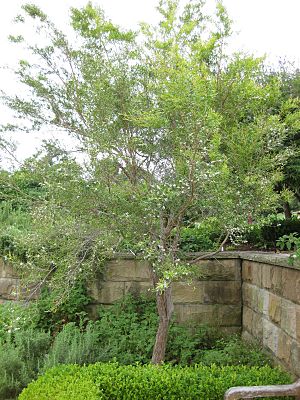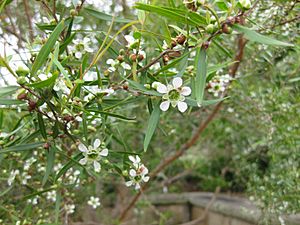Lemon-scented teatree facts for kids
Quick facts for kids Lemon-scented teatree |
|
|---|---|
 |
|
| Scientific classification | |
| Genus: |
Leptospermum
|
| Species: |
petersonii
|
| Synonyms | |
|
|
The lemon-scented teatree (scientific name: Leptospermum petersonii) is a special kind of shrub or small tree. It grows only in eastern Australia. This plant is famous for its thin, flaky bark and leaves that smell strongly of lemon. It has pretty white flowers and fruits that stay on the plant for a long time. People often grow it in gardens because it looks nice and smells good. However, it can sometimes spread too much in natural areas.
Contents
What Does the Lemon-Scented Teatree Look Like?
The lemon-scented teatree is usually a shrub or a small tree. It can grow to be about 5 meters (or more) tall. Its stems have thin, rough bark that can be fibrous or flaky. The younger branches are smooth and have a small ridge under where the leaves attach. New parts of the plant often have a reddish or purple color.
Leaves and Flowers
The leaves are shaped like an oval or a narrow spear. They are usually 20 to 40 millimeters long and 2 to 5 millimeters wide. They have a very strong lemon scent. These leaves do not have a stem connecting them to the branch.
The flowers are white and about 10 to 15 millimeters across. They usually grow one by one on short side branches. When the flower buds are forming, they have thin, papery, reddish-brown leaf-like parts called bracts at their base. These usually fall off as the bud grows.
The cup-shaped part of the flower (called the floral cup) is mostly smooth and dark-colored. It is about 3 to 4 millimeters long. The small leaf-like parts at the base of the flower (called sepals) are shaped like half a circle and are 1.5 to 2.5 millimeters long. The white petals are 5 to 6 millimeters long. Inside the flower, the stamens (which hold the pollen) are 2.5 to 3.5 millimeters long.
When It Blooms and Fruits
This plant mostly blooms from December to January. After flowering, it produces a round fruit called a capsule. These capsules are about 6 millimeters wide. They stay on the younger branches for a while but fall off as the plant gets older.
How It Got Its Name
The lemon-scented teatree was first officially described in 1905. A scientist named Frederick Manson Bailey wrote about it in a journal called the Queensland Agricultural Journal. He used a plant sample collected by W.J. Peterson in January 1905. That's why it's named petersonii after Mr. Peterson!
Where the Lemon-Scented Teatree Grows
This teatree grows in special types of forests in eastern Australia. You can find it in sclerophyll forests or rainforests. It often grows near creeks or on rocky cliffs. Its natural home stretches from Mount Timbeerwah in south-east Queensland down to near Port Macquarie in New South Wales.
How It Spreads
People often plant the lemon-scented teatree in their gardens. Sometimes, seeds from these garden plants spread into nearby natural areas. This means the plant can start growing in places where it doesn't naturally belong. It has become established in some areas outside its native range, like near Sydney and Melbourne in Australia, and even in Hawaii.
What Is the Lemon-Scented Teatree Used For?
This plant has some interesting uses, especially because of its strong lemon scent.
Essential Oils
The oil taken from the lemon-scented teatree can help stop the growth of certain tiny fungi. These fungi include Candida albicans and Aspergillus fumigatus. Scientists study how this oil can be useful.
Use in Gardens
The lemon-scented teatree is very popular as a garden plant. People love its fresh lemon smell and how attractive it looks. It grows quickly and can be trimmed to stay small like a shrub. Because it can be pruned often, it's great for making hedges or windbreaks. It's also grown by people who want to collect its essential oils.


